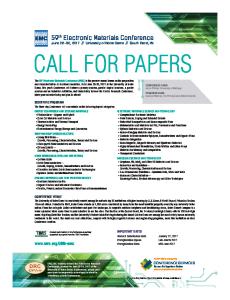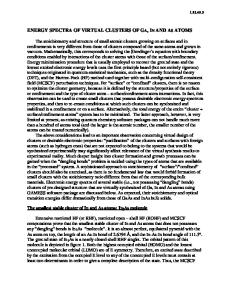Synthesis and Physical Properties of Skutterudite Superlattices
- PDF / 157,512 Bytes
- 6 Pages / 612 x 792 pts (letter) Page_size
- 70 Downloads / 312 Views
Synthesis and Physical Properties of Skutterudite Superlattices Joshua R. Williams, David C. Johnson1 Department of Chemistry and Materials Science Institute, University of Oregon, Eugene, OR 97403-1253 Michael Kaeser, Terry Tritt Department of Physics and Astronomy, Clemson University, Clemson, SC 29634-1905 George Nolas Research and Development Division, Marlow Industries, Dallas, TX 75238-1645 E. Nelson U. S. Army Research Laboratory, Adelphi, MD 20783
1
ABSTRACT Predicted and observed reductions in thermal conductivity of materials with superlattice structure have prompted interesting research into the possibility of using these materials as higher efficiency thermoelectrics. Synthesis of superlattice materials is challenging however, as the structure itself is generally not very stable at high temperatures as it is prone to interdiffusion. Presented here is the successful synthesis and characterization of a superlattice composed of two materials with the skutterudite structure, IrSb3 and CoSb3 . INTRODUCTION Thermoelectric materials have the very valuable potential to be used in two quite different, but technologically important areas: localized cooling applications and power generation. However, the low efficiency of current materials has limited their practical application. There is much ongoing research into different ways to increase the efficiency of current materials, as well as the design of new materials with potentially more favorable properties. Recent theoretical and experimental work [1,2,3,4,5,6,7] has demonstrated that superlattice materials may exhibit lower thermal conductivity than either of the constituent materials alone. This could be used to great advantage for applications such as thermoelectricity where low thermal conductivity materials are of great interest. Synthesis of superlattice materials is a major challenge however, and there have been only a few successful techniques developed. In this study, the modulated elemental reactant synthesis method was used to synthesize a superlattice material composed of the skutterudite compounds CoSb3 and IrSb3 . It has been suggested that this particular superlattice may have good transport properties for thermoelectric applications. EXPERIMENTAL The sample was deposited onto a silicon wafer, which was previously spin-coated with polymethylmethacrylate (PMMA). The deposition was performed in a high-vacuum deposition chamber described elsewhere [8]. Iridium and cobalt were deposited using electron beam evaporation guns. Antimony was deposited using a custom resistive heating cell. The background pressure in the chamber was lower than 5x10-6 during the entire deposition. A piece of zero-background quartz plate was attached to the silicon substrate during deposition, and was used for x-ray analysis of the film. After deposition, the substrate was removed from the
Z2.3.1
chamber and soaked in acetone to dissolve the PMMA and facilitate sample removal. The sample was filtered from the acetone and collected on Teflon filter paper. Differential Scan
Data Loading...











